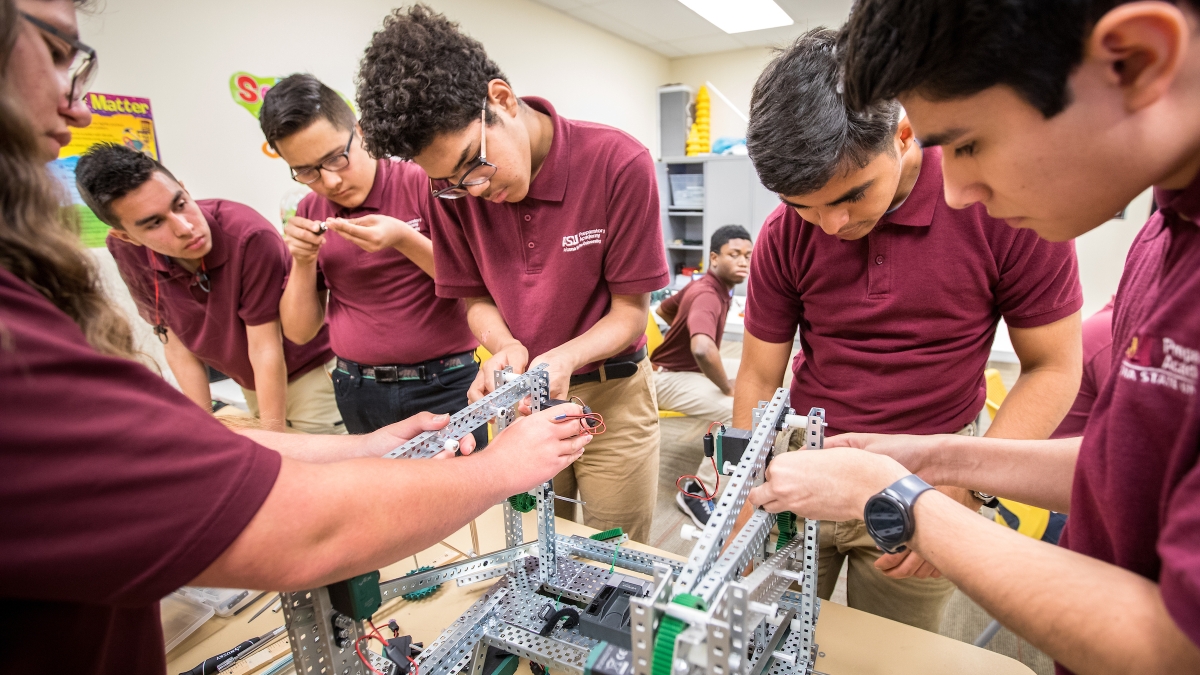The saga of this high school robotics team is a textbook Cinderella story.
Brand new school. No traditions or track records. Smart but inexperienced kids. Hardscrabble desert farm town.
In their first year of competition, the team from the Arizona State University Preparatory Academy of Casa Grande built a robot from scratch and made it to the state finals. Now, in their second year, they earned a slot in the world championships.
“We’re a surprise on the field,” science teacher and team adviser Sean Mark said.
But Team Chaos Theory has another hurdle to pass: raising money for the ten team members and their two faculty advisors to go to Louisville, Kentucky, for the competition in late April.
The team is doing what they can to raise the $8,500 they need — encouraging donation tax credits and holding a car wash on Saturday. Families have donated money for the trip, but there’s a long way to go, according to Mark.
“I’m really grateful to all the people who donate money,” team president Kevin Segovia said. “We always need parts. It’ll help us get a better robot in the end and help us get to Louisville.”
Video by Ken Fagan/ASU Now
Segovia never saw a trip to the world championships coming.
When he heard they qualified for the world competition, he wanted to smile and cry at the same time. “I was not expecting this,” he said.
The school has rallied around the team.
“We have a lot to celebrate,” school director Sylvia Mejia said. “This is such a life-changing event for the kids.”
Last year in the Maricopa County competition the team placed third. They then went on to the state competition, where they placed 23rd.
This year they placed second in the state competition, which qualified them to compete against 580 teams from 14 countries at the 2018 VEX Robotics World Championship.
Getting into the world championship would be an impressive achievement for an established school. But this is only the second year of operations for ASU Prep Casa Grande, a charter school geared entirely to getting students into college.
The students on the robotics team work as designers, programmers, builders, and prototypers for their robot, which stacks cones and moves autonomously. In competition it has to perform a set of tasks with a time limit. Accuracy counts, as does speed and placement on the course. There are size limits.
“It’s all clever design so it fits the parameters of what the competition allows,” Mark said.
Judges also award points for spirit, sportsmanship, and other subcategories. “When we are looking to compete, we’re also looking at all the awards we can compete for,” Mark said. “It’s been a great experience so far.”
The competition model is the seventh iteration of the design. “The biggest thing I learned is it doesn’t work the first time,” said Segovia, 17.
The programming side attracted Segovia, who wants to major in network engineering or cybersecurity in college.
“In general, robots just fascinate me,” he said.
Oluwamayowa Esan is team driver and programmer.
He described being a driver as fun, before adding, “nerve-wracking, but fun.”
“I’m super-excited about competition,” Esan said. “I just really like programming. … It’s just been a great ride doing that.”
To donate to the team, call the school at 520-374-4200 or contact faculty advisor Sean Mark. Donations up to $200 per person can also be made via tax credits.
Top photo: The students all have their assignments as they work on their VEX robot in ASU Preparatory Academy Casa Grande's robotics lab, on Thursday, March 29. The students have been invited to compete in the 2018 VEX Robotics World Championship in Louisville, in late April. The team will be competing against around 600 teams from 14 countries. Their robot will reach with double-reverse fore-bar arms to pick up cones and stack them on top of a mobile goal cone. Photo by Charlie Leight/ASU Now
More Science and technology

Turning up the light: Plants, semiconductors and fuel production
What can plants and semiconductors teach us about fuel production?ASU's Gary Moore hopes to find out.With the aim of learning how to create viable alternatives to fossil-based fuels, Moore — an…

ASU technical innovation enables more reliable and less expensive electricity
Growing demand for electricity is pushing the energy sector to innovate faster and deploy more resources to keep the lights on and costs low. Clean energy is being pursued with greater fervor,…

What do a spacecraft, a skeleton and an asteroid have in common? This ASU professor
NASA’s Lucy spacecraft will probe an asteroid as it flys by it on Sunday — one with a connection to the mission name.The asteroid is named Donaldjohanson, after Donald Johanson, who founded Arizona…


